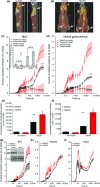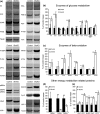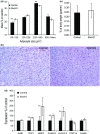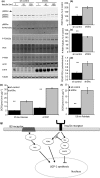Shc depletion stimulates brown fat activity in vivo and in vitro
- PMID: 25257068
- PMCID: PMC4244234
- DOI: 10.1111/acel.12267
Shc depletion stimulates brown fat activity in vivo and in vitro
Abstract
Adipose tissue is an important metabolic organ that integrates a wide array of homeostatic processes and is crucial for whole-body insulin sensitivity and energy metabolism. Brown adipose tissue (BAT) is a key thermogenic tissue with a well-established role in energy expenditure. BAT dissipates energy and protects against both hypothermia and obesity. Thus, BAT stimulation therapy is a rational strategy for the looming pandemic of obesity, whose consequences and comorbidities have a huge impact on the aged. Shc-deficient mice (ShcKO) were previously shown to be lean, insulin sensitive, and resistant to high-fat diet and obesity. We investigated the contribution of BAT to this phenotype. Insulin-dependent BAT glucose uptake was higher in ShcKO mice. Primary ShcKO BAT cells exhibited increased mitochondrial respiration; increased expression of several mitochondrial and lipid-oxidative enzymes was observed in ShcKO BAT. Levels of brown fat-specific markers of differentiation, UCP1, PRDM16, ELOVL3, and Cox8b, were higher in ShcKO BAT. In vitro, Shc knockdown in BAT cell line increased insulin sensitivity and metabolic activity. In vivo, pharmacological stimulation of ShcKO BAT resulted in higher energy expenditure. Conversely, pharmacological inhibition of BAT abolished the improved metabolic parameters, that is the increased insulin sensitivity and glucose tolerance of ShcKO mice. Similarly, in vitro Shc knockdown in BAT cell lines increased their expression of UCP1 and metabolic activity. These data suggest increased BAT activity significantly contributes to the improved metabolic phenotype of ShcKO mice.
Keywords: Shc; brown adipose; brown adipose tissue; energy expenditure; healthy aging; insulin.
© 2014 The Authors. Aging Cell published by the Anatomical Society and John Wiley & Sons Ltd.
Figures






Similar articles
-
The transcriptional co-regulator LDB1 is required for brown adipose function.Mol Metab. 2021 Nov;53:101284. doi: 10.1016/j.molmet.2021.101284. Epub 2021 Jun 29. Mol Metab. 2021. PMID: 34198011 Free PMC article.
-
The influence of Shc proteins and high-fat diet on energy metabolism of mice.Cell Biochem Funct. 2017 Dec;35(8):527-537. doi: 10.1002/cbf.3310. Cell Biochem Funct. 2017. PMID: 29243276 Free PMC article.
-
GHS-R in brown fat potentiates differential thermogenic responses under metabolic and thermal stresses.PLoS One. 2021 Apr 1;16(4):e0249420. doi: 10.1371/journal.pone.0249420. eCollection 2021. PLoS One. 2021. PMID: 33793646 Free PMC article.
-
Human Brown Adipose Tissue and Metabolic Health: Potential for Therapeutic Avenues.Cells. 2021 Nov 5;10(11):3030. doi: 10.3390/cells10113030. Cells. 2021. PMID: 34831253 Free PMC article. Review.
-
Origins and early development of the concept that brown adipose tissue thermogenesis is linked to energy balance and obesity.Biochimie. 2017 Mar;134:62-70. doi: 10.1016/j.biochi.2016.09.007. Epub 2016 Sep 10. Biochimie. 2017. PMID: 27621146 Review.
Cited by
-
Computational data of phytoconstituents from Hibiscus rosa-sinensis on various anti-obesity targets.Data Brief. 2019 May 16;24:103994. doi: 10.1016/j.dib.2019.103994. eCollection 2019 Jun. Data Brief. 2019. PMID: 31193691 Free PMC article.
-
Cartilage rings contribute to the proper embryonic tracheal epithelial differentiation, metabolism, and expression of inflammatory genes.Am J Physiol Lung Cell Mol Physiol. 2017 Feb 1;312(2):L196-L207. doi: 10.1152/ajplung.00127.2016. Epub 2016 Dec 9. Am J Physiol Lung Cell Mol Physiol. 2017. PMID: 27941074 Free PMC article.
-
Nuclear Localization of Mitochondrial TCA Cycle Enzymes as a Critical Step in Mammalian Zygotic Genome Activation.Cell. 2017 Jan 12;168(1-2):210-223.e11. doi: 10.1016/j.cell.2016.12.026. Epub 2017 Jan 12. Cell. 2017. PMID: 28086092 Free PMC article.
-
Shc and the mechanotransduction of cellular anchorage and metastasis.Small GTPases. 2019 Jan;10(1):64-71. doi: 10.1080/21541248.2016.1273172. Epub 2017 Feb 21. Small GTPases. 2019. PMID: 28632027 Free PMC article. Review.
-
Nonphagocytic Activation of NOX2 Is Implicated in Progressive Nonalcoholic Steatohepatitis During Aging.Hepatology. 2020 Oct;72(4):1204-1218. doi: 10.1002/hep.31118. Epub 2020 Oct 9. Hepatology. 2020. PMID: 31950520 Free PMC article.
References
-
- Ahfeldt T, Schinzel RT, Lee YK, Hendrickson D, Kaplan A, Lum DH, Camahort R, Xia F, Shay J, Rhee EP, Clish CB, Deo RC, Shen T, Lau FH, Cowley A, Mowrer G, Al-Siddiqi H, Nahrendorf M, Musunuru K, Gerszten RE, Rinn JL, Cowan CA. Programming human pluripotent stem cells into white and brown adipocytes. Nat. Cell Biol. 2012;14:209–219. - PMC - PubMed
-
- Boney CM, Sekimoto H, Gruppuso PA, Frackelton AR., Jr Src family tyrosine kinases participate in insulin-like growth factor I mitogenic signaling in 3T3-L1 cells. Cell Growth Differ. 2001;12:379–386. - PubMed
-
- Camici GG, Schiavoni M, Francia P, Bachschmid M, Martin-Padura I, Hersberger M, Tanner FC, Pelicci P, Volpe M, Anversa P, Luscher TF, Cosentino F. Genetic deletion of p66(Shc) adaptor protein prevents hyperglycemia-induced endothelial dysfunction and oxidative stress. Proc. Natl Acad. Sci. USA. 2007;104:5217–5222. - PMC - PubMed
Publication types
MeSH terms
Substances
Grants and funding
LinkOut - more resources
Full Text Sources
Other Literature Sources
Molecular Biology Databases
Miscellaneous

